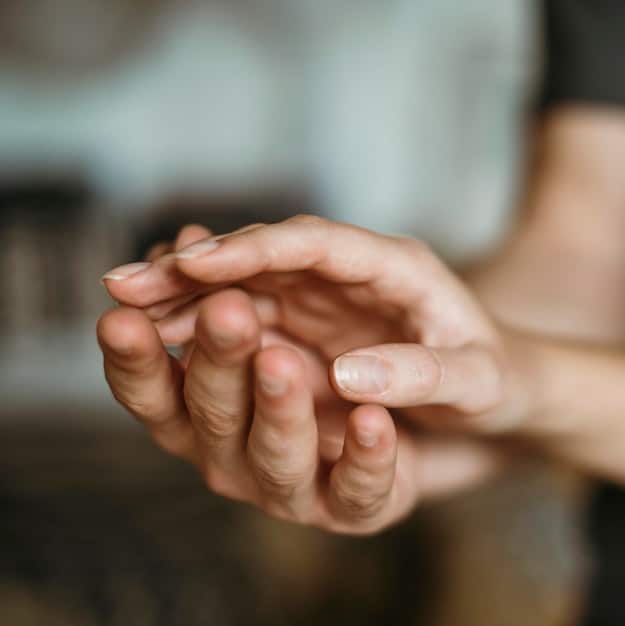Cultivate Gratitude: Daily Meditation for a Happier Life

Cultivate gratitude through daily meditation, a simple yet powerful practice, can significantly enhance your overall happiness and well-being by shifting your focus to the positive aspects of life.
Feeling stressed or overwhelmed? Discover how to cultivate gratitude with daily meditation, a straightforward technique for transforming your outlook and embracing a more joyful life. This article explores the profound benefits of gratitude meditation and provides a step-by-step guide to incorporating this enriching practice into your daily routine.
What is Gratitude Meditation?
Gratitude meditation is a specific type of mindfulness practice that focuses on appreciating and feeling thankful for the good things in your life. It’s a proactive way to shift your attention from what you lack to what you possess, fostering a sense of contentment and happiness.
Unlike other forms of meditation that might concentrate on breath awareness or emptying the mind, gratitude meditation encourages you to actively reflect on the things you are grateful for, big or small.
The Core Components
This practice typically involves consciously bringing to mind specific people, experiences, or things that evoke feelings of thankfulness. It’s about savoring those positive emotions and allowing them to fill your awareness.
- Reflection: Taking time to consider the aspects of your life you appreciate.
- Savoring: Fully experiencing the positive emotions associated with gratitude.
- Expression: Verbally or mentally expressing thankfulness.
By making gratitude a regular focus, you can train your mind to naturally notice and appreciate the positive aspects of your daily life, leading to a more optimistic and fulfilling experience.

The Science-Backed Benefits of Gratitude
Beyond just feeling good, gratitude has tangible benefits for your mental, emotional, and even physical health. Research consistently demonstrates the positive impact of practicing gratitude.
Studies have shown that regularly expressing gratitude can lead to increased happiness, reduced symptoms of depression, and improved sleep quality. It can also strengthen relationships and foster a greater sense of connection to others.
Specific Scientific Findings
Researchers have identified several key ways in which gratitude positively influences our well-being. These include altering brain activity, reducing stress hormones, and improving cardiovascular health.
- Improved Mental Health: Reduced symptoms of anxiety and depression.
- Enhanced Physical Health: Lower blood pressure and improved immune function.
- Stronger Relationships: Increased empathy and connection with others.
Incorporating gratitude into your daily routine is a scientifically validated method for enhancing your overall quality of life and building resilience against stress and adversity.
How to Start Your Daily Gratitude Meditation
Beginning a daily gratitude meditation practice does not require extensive experience or specialized training. It is a simple and accessible technique that can be easily integrated into your existing routine.
The key is to find a quiet and comfortable space where you can relax and focus without distractions. You can choose to practice in the morning, evening, or any other time that suits your schedule and preferences.
Step-by-Step Guide
Follow these steps to begin your daily gratitude meditation practice:
- Find a Quiet Space: Choose a calm environment where you won’t be disturbed.
- Get Comfortable: Sit in a relaxed posture or lie down if you prefer.
- Focus on Your Breath: Take a few deep breaths to center yourself.
- Reflect on Gratitude: Think about specific things you are grateful for.
- Savor the Feelings: Allow yourself to fully experience the positive emotions.
Start with just a few minutes each day and gradually increase the duration as you become more comfortable with the practice. Consistency is key for experiencing the full benefits of gratitude meditation.
Tips for Deepening Your Gratitude Practice
While the basic steps of gratitude meditation are straightforward, there are several techniques you can use to deepen your practice and enhance its impact.
One effective method is to maintain a gratitude journal, where you regularly write down specific things you are thankful for. This helps you to become more aware of the positive aspects of your life and to cultivate a habit of appreciation.
Advanced Techniques
Experiment with these additional techniques to enrich your gratitude practice:
- Visualize: Imagine the positive experiences in vivid detail.
- Express Gratitude to Others: Verbally thank people who have positively impacted your life.
- Focus on Small Things: Appreciate the simple pleasures of everyday life.
By incorporating these techniques, you can transform your gratitude meditation practice from a simple exercise into a deeply meaningful and transformative experience.

Common Challenges and How to Overcome Them
Like any new practice, you may encounter challenges when you first begin to cultivate gratitude with daily meditation. One common obstacle is difficulty focusing or feeling overwhelmed by negative thoughts.
It’s important to remember that it’s perfectly normal for your mind to wander during meditation. The key is to gently redirect your attention back to your breath or the things you are grateful for whenever you notice your thoughts drifting.
Addressing Obstacles
Here are some strategies for overcoming common challenges:
- Be Patient: It takes time to develop a consistent meditation practice.
- Start Small: Begin with just a few minutes each day and gradually increase the duration.
- Use Guided Meditations: Listen to guided meditations to help you focus.
With patience and persistence, you can overcome these challenges and develop a sustainable and rewarding gratitude meditation practice.
Integrating Gratitude into Your Daily Life
The benefits of gratitude extend far beyond the meditation cushion. By consciously integrating gratitude into your daily life, you can cultivate a more positive and appreciative mindset that permeates all aspects of your experience.
One simple way to do this is to make a habit of expressing gratitude to others. Verbally thank people who have helped you, or write thank-you notes to show your appreciation.
Practical Applications
Here are some additional ways to integrate gratitude into your daily life:
- Keep a Gratitude Journal: Regularly write down things you are thankful for.
- Practice Mindful Appreciation: Savor the simple pleasures of everyday life.
- Express Gratitude to Yourself: Acknowledge your own strengths and accomplishments.
By consciously integrating gratitude into your daily life, you can create a ripple effect of positivity that enhances your relationships, boosts your well-being, and transforms your overall outlook.
| Key Point | Brief Description |
|---|---|
| 😊 Daily Reflection | Take time each day to reflect on things you’re grateful for. |
| 🧠 Mental Benefits | Gratitude meditation reduces stress and boosts happiness levels. |
| ✍️ Journaling | Keep a journal to document and deepen your feelings of gratitude. |
| 🤝 Relationships | Expressing gratitude strengthens bonds with others. |
Frequently Asked Questions (FAQ)
▼
The best time to practice gratitude meditation is whenever it fits comfortably into your daily routine. Many people find that practicing in the morning helps to set a positive tone for the day, while others prefer to practice in the evening as a way to wind down and reflect on the day’s blessings.
▼
You can start seeing benefits from gratitude meditation with as little as 5-10 minutes of practice each day. Consistency is key, so it’s better to meditate for a shorter period regularly than to meditate for a longer period sporadically.
▼
If you’re having trouble feeling grateful, start by focusing on the simple things in your life that you appreciate, such as a comfortable bed, a warm cup of coffee, or a beautiful sunset. You can also try reflecting on times when you received help or support from others.
▼
Yes, gratitude meditation can be a helpful tool for managing anxiety. By shifting your focus to the positive aspects of your life, you can reduce feelings of stress and worry. Regular practice can help you develop a more balanced and resilient mindset.
▼
While keeping a gratitude journal is not strictly necessary, it can be a helpful way to deepen your practice and cultivate a greater sense of appreciation. Writing down the things you are grateful for can help you to become more aware of the positive aspects of your life and to reinforce your feelings of thankfulness.
Conclusion
Incorporating gratitude into your daily life through meditation is a simple yet powerful way to enhance your happiness and well-being. By taking time each day to appreciate the good things in your life, you can shift your focus from what you lack to what you possess, fostering a sense of contentment and joy. Start your gratitude journey today and experience the transformative benefits for yourself.





